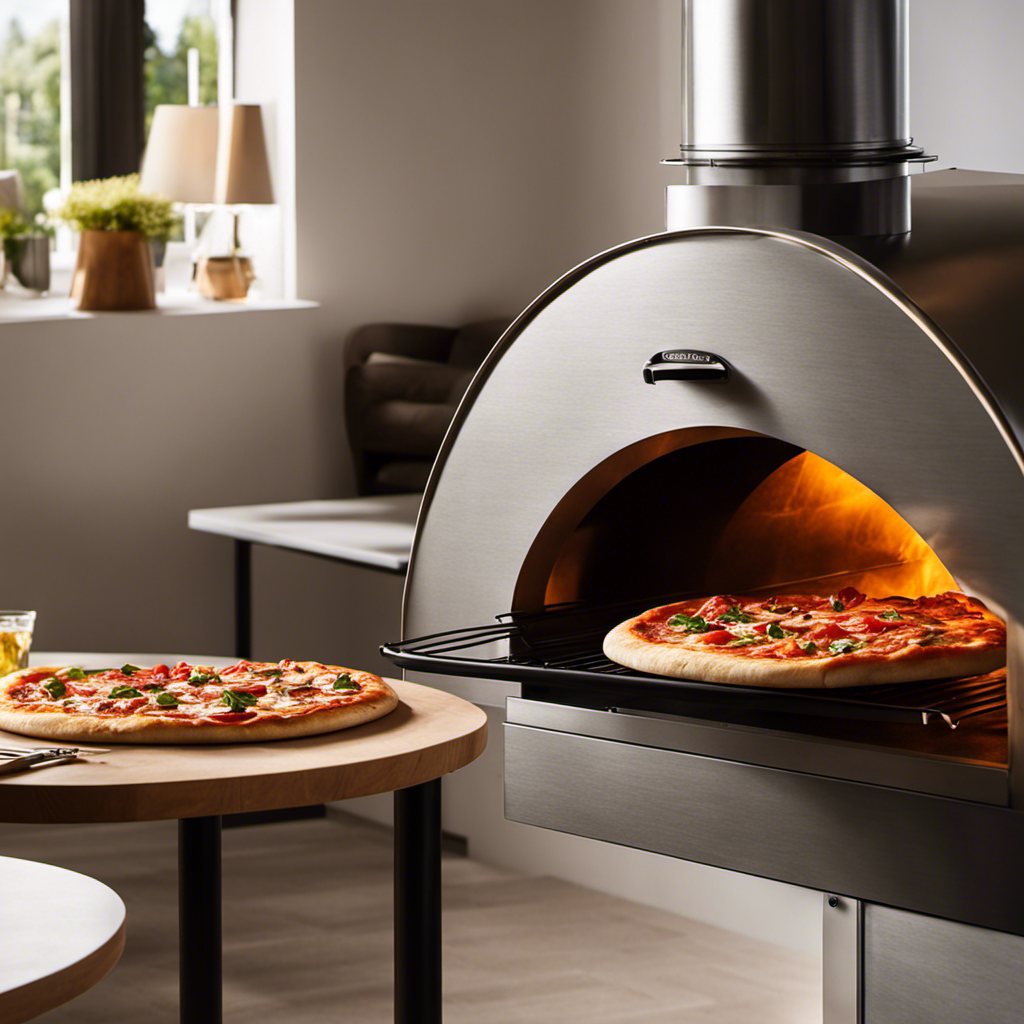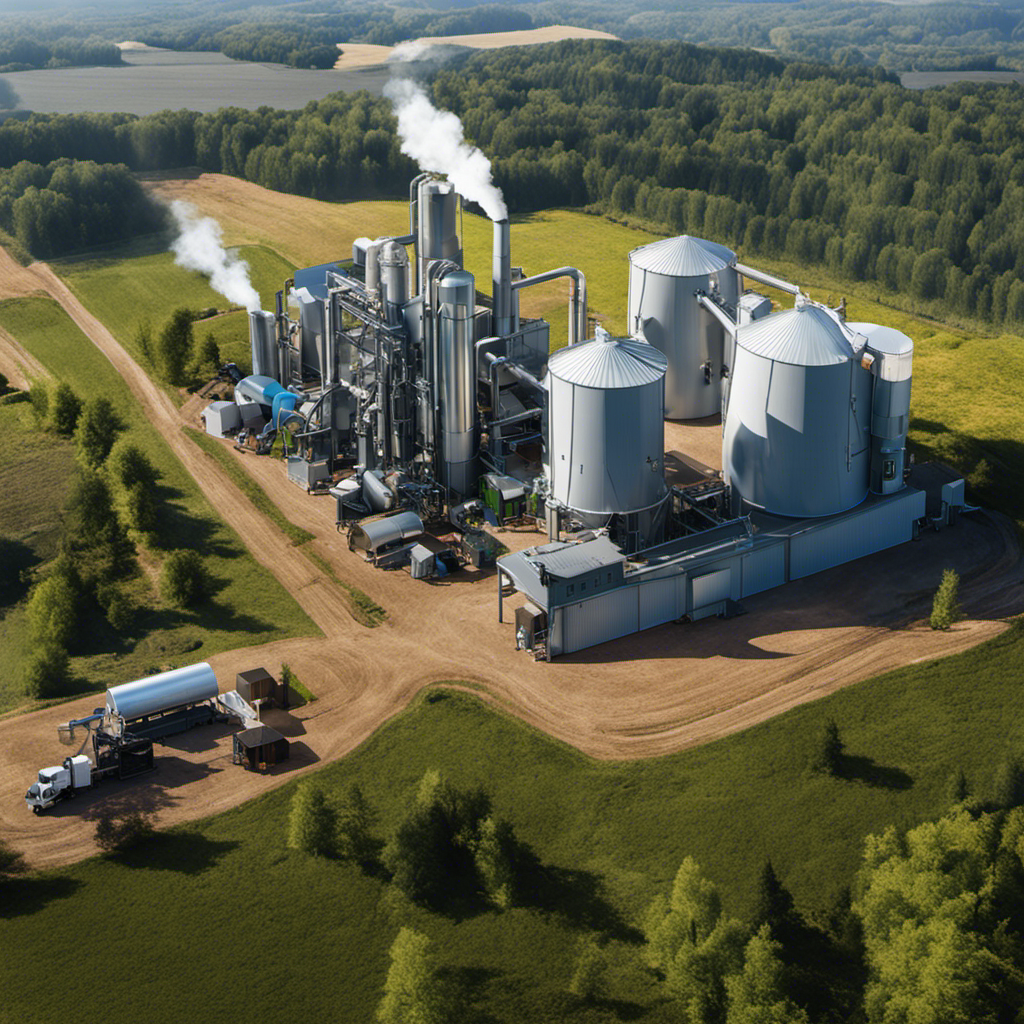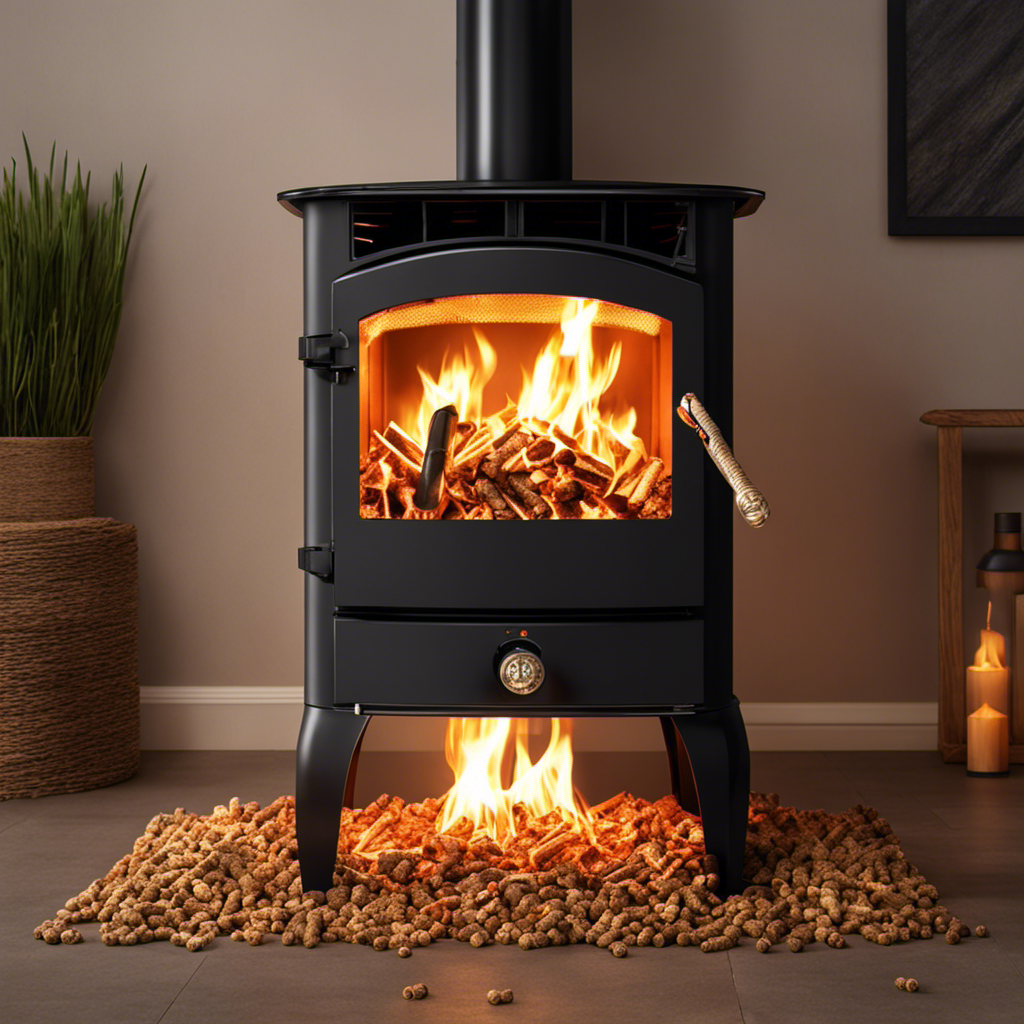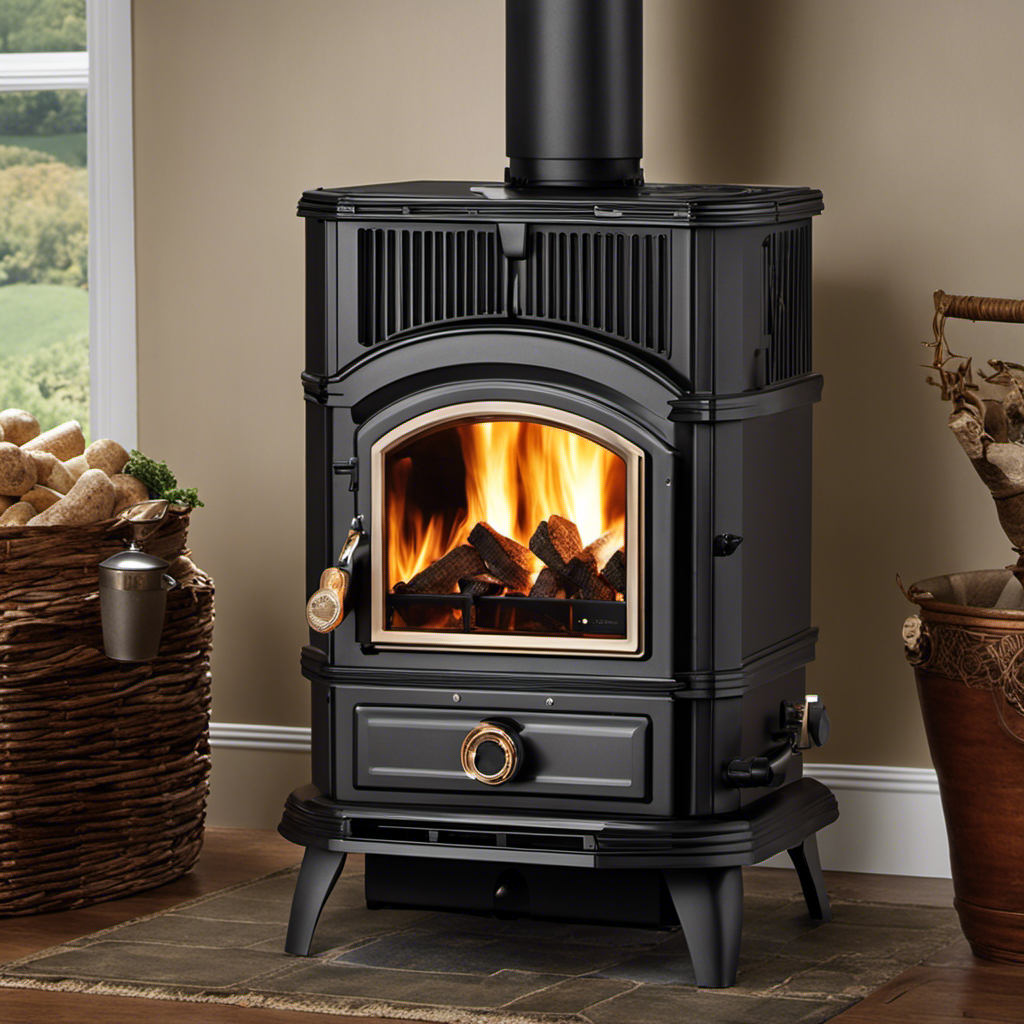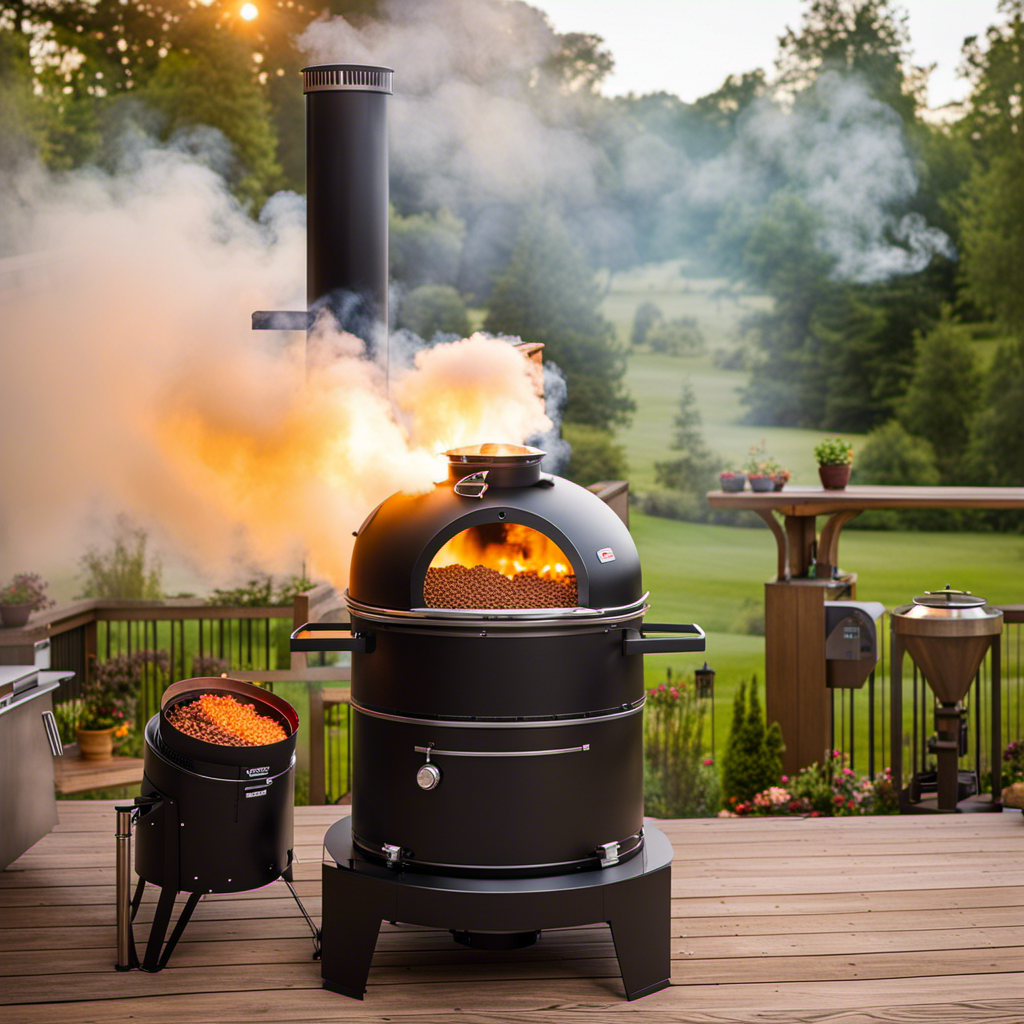I’ve always been a fan of the genuine, strong taste of wood-fired pizza, yet I questioned my capability to replicate it until I stumbled upon the impressive capabilities of a wood pellet pizza oven.
In this article, I’ll show you step by step how to use this incredible cooking tool to make mouthwatering pizzas right in your backyard.
From choosing the right wood pellets to perfecting your dough and toppings, we’ll cover everything you need to know for a truly unforgettable pizza experience.
Get ready to impress your friends and family with your newfound pizza-making skills!
Key Takeaways
- Choose the right type of wood pellets for your pizza oven, considering the flavor profile and moisture content.
- Properly prepare and maintain your pizza oven by regularly cleaning ash, inspecting the chimney, and replacing worn gaskets.
- Ignite and control the wood pellet fire by using kindling, adjusting airflow, and monitoring temperature consistently.
- Pay attention to dough consistency and rising, experiment with different toppings, and thinly slice ingredients for even cooking in the wood pellet oven.
Choosing the Right Wood Pellets
When choosing the right wood pellets, it’s important to consider the type of wood and its moisture content. Wood pellet availability may vary depending on your location, but there are usually a few options to choose from. Some common types include oak, hickory, applewood, and cherry wood pellets. Each type of wood imparts a unique flavor profile to your pizza.
Oak pellets provide a strong smoky flavor, while hickory adds a bold and robust taste. Applewood gives a slightly sweet and fruity essence, while cherry wood brings a subtle hint of sweetness with a touch of tartness. It’s also crucial to ensure that the moisture content of the pellets is low enough for efficient burning and generating high heat in the pizza oven.
Now that you have chosen the perfect wood pellets for your pizza oven, let’s move on to preparing it for use…
Preparing the Pizza Oven for Use
First, make sure you’ve properly set up your pizza oven before firing it up. Proper pizza oven maintenance is crucial to ensure optimal performance and prevent common issues that may arise during use. Here are some troubleshooting tips for maintaining your wood pellet pizza oven:
| Maintenance Tips | Troubleshooting Common Issues |
|---|---|
| Clean the ash regularly | Uneven heat distribution |
| Check and replace worn gaskets | Difficulty in igniting fire |
| Inspect and clean the chimney | Excessive smoke production |
| Lubricate moving parts | Inconsistent temperature |
| Ensure proper air ventilation | Pellet jamming |
Igniting the Wood Pellet Fire
To ensure a successful fire, check that the gaskets aren’t worn and replace them if necessary. Proper lighting techniques are essential for igniting the wood pellet fire in your pizza oven. Here’s what you need to know:
- Use a long-reach lighter or a propane torch to ignite the pellets.
- Start by placing a small amount of kindling at the bottom of the firebox.
- This will help create an initial flame and provide heat to ignite the pellets.
- Make sure to position the kindling in such a way that air can circulate around it.
Maintaining the fire is crucial for achieving optimal cooking temperatures. Keep these points in mind:
- Add more pellets as needed to maintain consistent heat throughout the cooking process.
- Monitor the flame intensity and adjust airflow accordingly using any available dampers or vents on your pizza oven.
By mastering these lighting techniques and maintaining a steady fire, you’ll be well on your way to enjoying delicious wood-fired pizzas.
Now let’s move on to controlling the temperature without compromising flavor or texture.
Controlling the Temperature
Make sure you monitor the temperature consistently throughout the cooking process to ensure your wood-fired pizzas come out perfectly. Temperature control is crucial when using a wood pellet pizza oven, as it directly affects the outcome of your pizzas. To help you understand this better, here’s a table outlining the recommended temperature ranges for different types of pizzas:
| Pizza Type | Temperature Range |
|---|---|
| Margherita | 450-500°F |
| Pepperoni | 500-550°F |
| Vegetarian | 400-450°F |
| BBQ Chicken | 550-600°F |
| Hawaiian | 400-450°F |
To achieve these temperatures, you need to understand how your oven’s heating elements work. Most wood pellet pizza ovens have adjustable dials or digital controls that allow you to set and maintain the desired temperature. The heating elements, usually located at the back or bottom of the oven, are responsible for generating and distributing heat evenly.
Now that we’ve covered temperature control and heating elements, let’s move on to preparing the pizza dough and toppings for an unforgettable wood-fired pizza experience.
Preparing the Pizza Dough and Toppings
When it comes to preparing the perfect pizza, two key factors that cannot be overlooked are dough consistency and rising. Achieving the right consistency for the dough is crucial for a crispy yet chewy crust, while allowing it to rise properly ensures a light and airy texture.
Additionally, selecting and preparing the right toppings can make or break your pizza. From choosing fresh ingredients to properly cooking and seasoning them, each step plays a vital role in creating a delicious final product.
Dough Consistency and Rising
The dough should be soft and elastic for optimal rising in the wood pellet pizza oven. When it comes to types of pizza dough, there are various options to choose from. You can go for a classic Neapolitan-style dough, which is made with flour, water, salt, and yeast. Alternatively, you could try a thin crust dough or even a gluten-free version using alternative flours.
Troubleshooting dough problems is also important to ensure successful baking. If your dough doesn’t rise properly, it could be due to issues like improper yeast activation or inadequate proofing time. Adjusting these factors can help achieve the desired consistency and rise for your pizzas.
Now that we have our perfect dough ready, let’s move on to topping selection and preparation.
NEXT SUBTOPIC: ‘Topping Selection and Preparation’
Topping Selection and Preparation
For optimal flavor and variety, it’s important to experiment with different toppings and preparation techniques for your pizzas. When it comes to pizza dough recipes, there are countless options available that can cater to your preferences. Whether you prefer a thin and crispy crust or a thick and chewy one, you can find a recipe that suits your taste.
As for the toppings, don’t be afraid to get creative! Traditional options like pepperoni and mozzarella are always delicious, but why not try something unique like prosciutto and figs or barbecue chicken with caramelized onions? The possibilities are endless.
Preparing the toppings is just as important as choosing them. Make sure to slice your ingredients thinly so they cook evenly in the wood pellet oven.
Transitioning into cooking the pizza in a wood pellet oven…
Cooking the Pizza in a Wood Pellet Oven
When it comes to cooking the perfect pizza in a wood pellet oven, two key factors to consider are the optimal cooking temperature and the best pizza toppings.
The optimal cooking temperature for a wood pellet oven is typically around 700-900 degrees Fahrenheit. This high heat ensures a crispy crust and evenly cooked toppings.
As for the best pizza toppings, it ultimately depends on personal preference. Popular choices include classic options like pepperoni and mozzarella or more adventurous combinations like prosciutto and arugula.
Experimenting with different topping combinations can lead to delicious results that cater to your unique taste buds.
Optimal Cooking Temperature
To achieve the best cooking results, you’ll want to preheat your wood pellet pizza oven to the optimal temperature. Cooking in a wood pellet oven requires precise temperature control to ensure that your pizza comes out perfectly cooked with a crispy crust and melted toppings. The ideal temperature for cooking pizza in a wood pellet oven is around 500-550°F (260-290°C). This high heat allows the dough to cook quickly and develop that desired charred flavor. To help you visualize the importance of temperature control, here’s a table showcasing the different cooking techniques at various temperatures:
| Temperature (°F) | Cooking Technique | Result |
|---|---|---|
| 400-425 | Slow and low | Soft crust, longer bake |
| 450-475 | Moderate heat | Balanced texture |
| 500-550 | High heat | Crispy crust, quick cook |
Now that we understand the significance of temperature control, let’s move on to discussing the best pizza toppings that complement wood-fired flavors without compromising taste or texture.
Best Pizza Toppings
Now that we know the optimal cooking temperature for our wood pellet pizza oven, let’s move on to discussing the best pizza toppings.
When it comes to creating the perfect pizza, choosing the right ingredients is crucial. Start with a good quality pizza crust – whether you prefer thin and crispy or thick and chewy, there are endless options available at your local grocery store or you can even make your own from scratch.
As for sauce options, classic tomato sauce is always a safe bet, but don’t be afraid to experiment with alternatives like pesto or white garlic sauce for a different flavor profile. Remember to evenly spread the sauce on your crust, leaving enough room for your desired toppings.
And now that we have covered the topic of best pizza toppings, let’s move on to discuss the important aspect of cleaning and maintenance of the pizza oven…
Cleaning and Maintenance of the Pizza Oven
You should regularly clean and maintain the pizza oven to ensure it functions properly. Proper cleaning techniques are essential for keeping your pizza oven in top shape.
Start by removing any leftover ashes or debris from the cooking chamber using a brush or scraper. Next, wipe down the interior and exterior surfaces with a damp cloth and mild detergent. Be sure to avoid using abrasive cleaners that could damage the oven’s finish. For stubborn stains, you can create a paste of baking soda and water and gently scrub the affected area.
Additionally, it’s important to troubleshoot common issues that may arise with your pizza oven. These can include temperature fluctuations, uneven cooking, or difficulty starting the fire. Consult the manufacturer’s instructions for specific troubleshooting steps or contact customer support for assistance if needed.
Regular cleaning and maintenance will prolong the life of your pizza oven and ensure delicious pizzas every time you use it.
Frequently Asked Questions
How Long Should I Let the Wood Pellets Soak Before Using Them in the Pizza Oven?
I usually soak the wood pellets for about 30 minutes before using them in my pizza oven. This allows them to absorb moisture and burn more slowly, giving my pizzas a smoky flavor.
Can I Use Regular Wood Chips Instead of Wood Pellets in the Pizza Oven?
Yes, you can use regular wood chips instead of wood pellets in a wood pellet pizza oven. However, there are pros and cons to consider. Wood chips may produce more smoke and require more frequent refilling compared to wood pellets.
How Often Should I Clean the Ash Out of the Pizza Oven?
I clean the ash out of my wood pellet pizza oven every 5-6 uses. It’s important to maintain the ash buildup to ensure proper airflow and prevent any unwanted flavors in the pizzas.
Can I Cook Other Foods Besides Pizza in a Wood Pellet Oven?
Yes, you can definitely cook other foods besides pizza in a wood pellet oven. Some cooking alternatives include roasting vegetables, baking bread, and grilling meats. I have some recipe suggestions if you’d like!
Is It Safe to Leave the Pizza Oven Unattended While It Is in Use?
When using a wood pellet pizza oven, it is important to prioritize safety. Never leave the oven unattended while in use. Follow proper maintenance tips to ensure safe and efficient operation.
Conclusion
In conclusion, using a wood pellet pizza oven can take your pizza-making skills to the next level. By choosing the right wood pellets and following the proper steps for preparing and igniting the fire, controlling the temperature, and cooking the pizza, you can achieve delicious and perfectly cooked pizzas every time.
For example, Sarah from New York recently purchased a wood pellet pizza oven and was amazed at how quickly she could make restaurant-quality pizzas in her own backyard. The smoky flavor imparted by the wood pellets made her pizzas taste even better than those from her favorite pizzerias.
With regular cleaning and maintenance, your wood pellet pizza oven will continue to bring joy to your family and friends for years to come.

